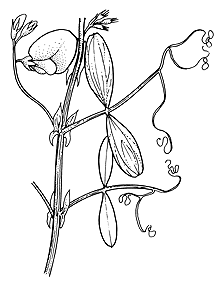
Description: Climbing annual or perennial herbs; stems sometimes winged.
Leaves paripinnate, terminal leaflet modified to a tendril or bristle, venation longitudinal; stipules entire or rarely toothed.
Inflorescences axillary, racemes or flowers solitary; bracts narrow, often caducous; bracteoles absent. Calyx campanulate. Standard broad, ± longer than wings or keel; wings sometimes joined to the keel; keel apex usually obtuse. Stamens diadelphous; anthers uniform. Ovary ± sessile or stipitate, ovules 2–many; style inflexed, compressed, pubescent on upper side; stigma terminal or capitate.
Pod compressed, upper suture often 2-winged, usually dehiscent; seeds ± globose, arillate.
Distribution and occurrence: World: 130 species, southern temperate regions. Australia: 5 species (naturalized), all States except N.T.
The Sweet Pea, L. odorarus L., is commonly cultivated as an ornamental.
Text by C. Gardner
Taxon concept:
| | Key to the species | |
| 1 | Stems less than 60 cm long, not winged; flowers solitary or rarely paired | Lathyrus angulatus |
| Stems 60–300 cm long, distinctly winged; flowers in racemes of 1–15 flowers | 2 |
| 2 | Racemes with 1–3 flowers; flowers deep pink or deep purple; seeds smooth | Lathyrus tingitanus |
| Racemes with 3–15 flowers; flowers dark purple to white; seeds wrinkled
Back to 1 | Lathyrus latifolius |
|


